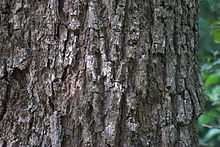Mimusops elengi
| Mimusops elengi | |
|---|---|
 | |
| Scientific classification | |
| Kingdom: | Plantae |
| (unranked): | Angiosperms |
| (unranked): | Eudicots |
| (unranked): | Asterids |
| Order: | Ericales |
| Family: | Sapotaceae |
| Genus: | Mimusops |
| Species: | M. elengi |
| Binomial name | |
| Mimusops elengi L. | |
_ripe_fruit_in_Kolkata_W_IMG_2833.jpg)
Mimusops elengi is a medium-sized evergreen tree found in tropical forests in South Asia, Southeast Asia and northern Australia. English common names include Spanish cherry,[1] medlar,[1] and bullet wood. In it is called maulsari in Hindi, bakul in Sanskrit, Marathi, Bengali,Bokul in Assamese,"Elanji" (ഇലഞ്ഞി) in Malayalam, Manipuri, magizamaram மகிழ், மகிழமரம் and ilanji இலஞ்சி in Tamil, AND ranja "Bakula" (ಬಕುಲ), "Pagade Mara" "Vajradhanthi" in Kannada.[2] Its timber is valuable, the fruit is edible, and it is used in traditional medicine. As the trees give thick shade and flowers emit fragrance, it is a prized collection of gardens.[3]
Its flower is the provincial flower of Yala Province, Thailand.[4]
Tree description
_in_Hyderabad_W_IMG_7161.jpg)


Bullet wood is an evergreen tree reaching a height of about 16 m. It flowers in April, and fruiting occurs in June. Leaves are glossy, dark green, oval-shaped, 5–14 cm long, and 2.5–6 cm wide. Flowers are cream, hairy, and scented. Bark is thick and appears dark brownish black or grayish black in colour, with striations and a few cracks on the surface. The tree may reach up to a height of 9–18 m with about 1 m in circumference.
Ayurvedic uses
The bark, flowers, fruits, and seeds of Bakula[5] are astringent, cooling, anthelmintic, tonic, and febrifuge. It is mainly used in dental ailments like bleeding gums, pyorrhea, dental caries, and loose teeth.[5]
Extracts of flowers are used against heart diseases, leucorrhoea, and menorrhagia, and act as antiduretic in polyuria and antitoxin. The snuff made from the dried and powdered flowers is used in a disease called ahwa in which strong fever, headache, and pain in the neck, shoulders, and other parts of the body occurs.
Ripened fruits facilitate a cure for burning urination. The ripe fruit pounded and mixed with water is given to promote delivery in childbirth. The powder of dried flowers is a brain tonic and useful as a snuff to relieve headache. Decoction of bark is used to wash the wounds.
Other uses
- The edible fruit is softly hairy becoming smooth, ovoid, bright red-orange when ripe.
- The wood is a luxurious wood that is extremely hard, strong and tough, and rich deep red in color. The heart wood is sharply defined from the sapwood. It works easily and takes a beautiful polish. Weight is 1008 kg per cubic meter.
- Flowers have light fragrance which is retained even after flowers are dried and are used to make ornamental garlands offered for pooja throughout India.[5][3]
References
| Wikimedia Commons has media related to Mimusops elengi. |
- ↑ 1.0 1.1 Bailey, L.H.; Bailey, E.Z.; the staff of the Liberty Hyde Bailey Hortorium. 1976. Hortus third: A concise dictionary of plants cultivated in the United States and Canada. Macmillan, New York.
- ↑ "Mimusops elengi". Biodiversity India. Retrieved 14 October 2013.
- ↑ 3.0 3.1 "Maulsari". flowersofindia.com. Retrieved 14 October 2013.
- ↑ ประวัติ จังหวัด ยะลา-Yala Province
- ↑ 5.0 5.1 5.2 "Bakula – an Indian plant with interesting properties". Natural Actives. Retrieved 14 October 2013.
Further reading
- Brock, J., Top End Native Plants, 1988. ISBN 0-7316-0859-3